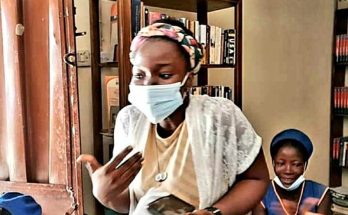<Artwork by Rica Mae Soriente for Camille Diola>
The Philippine weather bureau called Typhoon Rai “Odette” as it approached in December 2021, in a country that counts down to Christmas at the start of September. Within the Pacific’s typhoon belt, the news typically runs storm signals, forecast tracks and evacuation advisories before violent blows touch land.
This time though, the news did not reach all the areas it used to. The government, on a whim, had shuttered ABS-CBN’s free TV broadcast. The farthest-reaching network had been gone for a year when Odette turned out to be a rare beast, rapidly intensifying from a low-end swirler into a Category 5-equivalent right when it began to sweep across the predominantly coastal center of the archipelago.
Journalist Romeo Subaldo received a distressing tip: dozens had died in Sipalay, a beach city in southern Negros. Many were unaware the typhoon isolated the area, knocking down power and phone signals. He got in his car and drove south for four hours.
But debris obstructed the road and he failed to reach Sipalay. He went on another lengthy drive through the ravaged landscapes the next day, only to find the way to the city still impassable. For his third attempt, he asked community sponsors to donate 500 loaves of bread. He also enlisted his cameraman.
“We were able to penetrate the area and were the first non-Sipalay residents to reach the city proper,” Subaldo said.
As the two-man crew filmed and distributed bread, he met a father who asked for cardboard boxes to sleep on. His family were among those who saw their homes destroyed, spending nights on the cold, bare concrete of the road, just three days before Christmas.
Subaldo reported the visit on Digicast Negros, a video-driven Facebook page he and his colleagues launched after losing their jobs when ABS-CBN closed down. Soon afterward, NGOs began calling to dispatch aid and relief to Sipalay.
In places like Negros, where traditional media are fading, news providers like Digicast and their tiny teams are lifelines to communities, extending journalism’s reach. Termed “hyperlocals” by scholars, these often cash-strapped independent pages and sites offset the scarcity of journalism in areas at risk of becoming news deserts.
Subaldo initially funded operations with his severance from ABS-CBN in 2020, and integrated journalistic rules with techniques of influencer vlogs. The format afforded freedom, contrasting with TV’s stiffness, and made resulting video stories compelling to local viewers.
Digicast’s five-member operations have since earned mainly from video ads, whether from its Facebook page which has 300,000 followers or from local businesses eager for exposure in tourism and “good news” segments. A sliver of sales comes from Google ads on its website.
Besides the format, the organization’s culture is also freeing. His staff are employed full-time but are not bound to eight-hour days. Instead, they pursue side hustles, such as anchoring radio segments, selling frozen food, delivering water and running car rentals.
“We removed the toxicity in the workplace… that’s why people are staying,” Subaldo said.
While he managed to recover his capital in three years, Subaldo worries Digicast may not keep pace with technology and trends. Thinning ad buys is also a creeping concern.
In the Bangsamoro Autonomous Region, the nation’s poorest, established in 2019 after a 50-year war and two decades of peace talks, Cotabato-based Ferdinand Cabrera and his Kutangbato News on Facebook report on clashes between state forces and Maoist rebels, regional assemblies and even sea otter sightings.
Originally a blog for Cabrera’s daily reporting in 2014, Kutangbato evolved into a local wire with a newscast. A correspondent for national and international news agencies, he believes fuller versions of stories should be heard and in Filipino, a common tongue in the multilingual region.
The Bangsamoro Electoral Code, approved in 2023, follows a parliamentary system unique to the region. While national news and broadcast TV would clip his stories, Kutangbato provided Cabrera the freedom to explore the code’s complexities with depth and nuance.
“Print has a different taste, and TV is also different… Now I have independence of telling my stories in video,” he said.
The startup, which has 154,000 Facebook follows, operates with a lean team of eight, including camera operators, an editor, a reporter and transcribers. They all serve as stringers for other companies. Cabrera himself supplies stories to radio stations. Receiving pay from only one outlet would not suffice.
Advertisers, too, are an indefinite prospect for Kutangbato. Its usual clients are NGOs where Cabrera, the publisher, has friends who commission projects. “But now that’s drying up,” he said.
He admitted a weakness in its model: he has no time to sell or check how well the content is doing.
“I have dreams for it to grow, but the media landscape is changing so fast… even CNN Philippines, which is a large company, closed. How much more for me? It may turn out I can’t sustain this when there are no clients. Will it return to being a blog?” he added, citing the free TV network’s shutdown in January.
Hyperlocals often operate with virtual newsrooms and make do without sales and marketing teams. Researcher Raizza Bello, who analyzed a mapping of news sites in the Philippines, observed they are not built to host automated ads and explore more sophisticated ways to earn.
“In the regions, resources are really lean. We’re not sure if newsrooms really know the kinds of advertisements that can be placed or if they’re even asking whether an advertising model would work given the context,” Bello said.

<Artwork by Rica Mae Soriente for Camille Diola>
While national media remain relevant due to their wide reach, local outlets have traditionally banked on their ties with local businesses, institutions and even government. On the one hand, social media has upended the business that used to support journalism, but it has also reinforced local involvement and interest.
This was what Harthwell Capistrano banked on in building a local news outlet. While traveling to northern Palawan with his business partners in 2017, Capistrano, a former national news correspondent, noticed that crucial information did not reach locals. In just three weeks, they launched Palawan Daily, initially as a website and then started a weekly newsprint after a year.
Capistrano now heads a seven-man news company, while juggling day jobs as a Qatar-based oil firm manager and executive of a technical training facility he started in the province.
The yearend breakeven is always uncertain, Capistrano admits. Printing campaign materials and legal notices has brought income to others, but his publication shuns transactions with officials. “It’s a struggle because it’s a self-funded company,” he explained.
To save costs, Capistrano housed the news organization in a shared space with the training company and fused admin and HR resources. Without his overseas work and another business supporting it as a main advertiser, Palawan Daily might not survive.
“Sometimes, I ask myself why we are in this instead of traveling and taking vacations. I think it’s because journalism for me is beyond business,” he said. “Also, l’m looking after it for the employees.”
Palawan Daily, which has nearly 100,000 visits on its website monthly, relies on local advertisers. Posts on its Facebook page, which has 156,000 followers, alternate between news items, light-hearted public projects and photos of dining spots across the province.
Capistrano plans to add an income stream when it has found a way to train its staff. “Part of our plan is to have mobile journalism, to have more video content, because video has a much higher engagement.”
The long term for any business in a precarious industry is often open-ended. For Red Batario, head of the Center for Community Journalism and Development, the biggest challenge is to find a way to stem the “erosion of readership and loss of advertising support.”
Batario suggests forming geographic clusters among local publishers to make them responsive and resilient against economic shifts and political pressures. A network can also encourage support, shared learning, rationalized earning and funding, and professionalization.
Bello proposes a similar model, a structure that streamlines and operates sales and other functions for different newsrooms. Through it, local news ventures can build capacity to earn from varied channels.
What they find is not an option in a fragile democracy is to forego local journalism. When ABS-CBN’s Negros broadcast was going off air in 2020, a year before Super Typhoon Odette swept across Sipalay and central Philippines, locals approached Subaldo and his colleagues. “We can’t do without a source of local news that is not radio,” he said, quoting community members.
The team that would set up Digicast was reluctant at first, but decided to take the risk after learning that another community paper, the Visayan Daily Star, would not survive the pandemic-induced downturn. Later, it was Digicast that paved the way—quite literally—for Sipalay to have shelter in time for Christmas.
Cabrera, who is still shoring up Kutangbato, thinks journalists should dare become entrepreneurs. “In the case of journalists from ABS-CBN and CNN Philippines… why not organize yourselves again according to region? You can own it.”
But, he also asks, who will teach them to market and earn? “We’re not good at that. The talents and skills, the expertise, though, is already there,” he said. #




